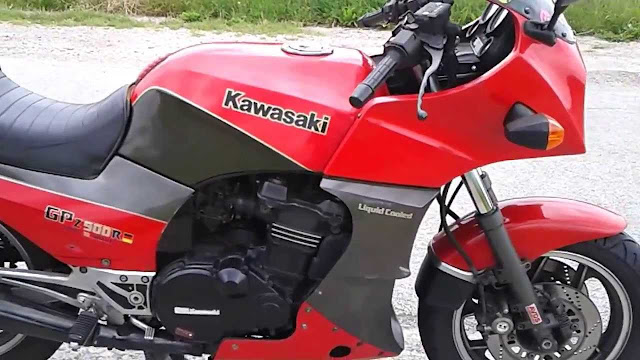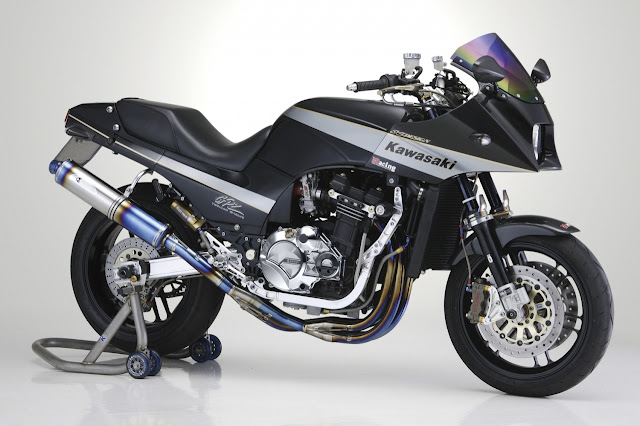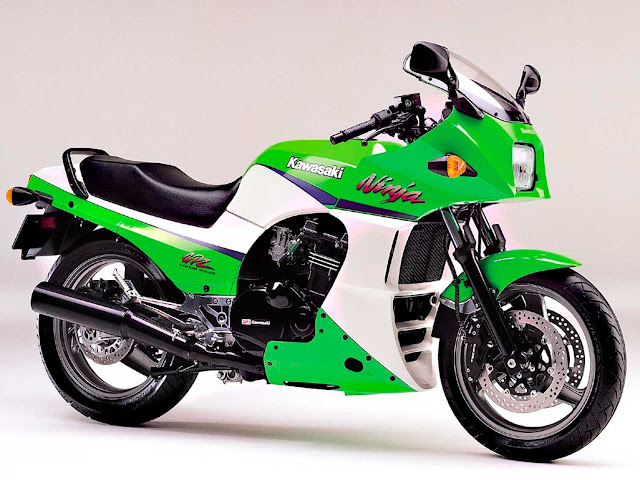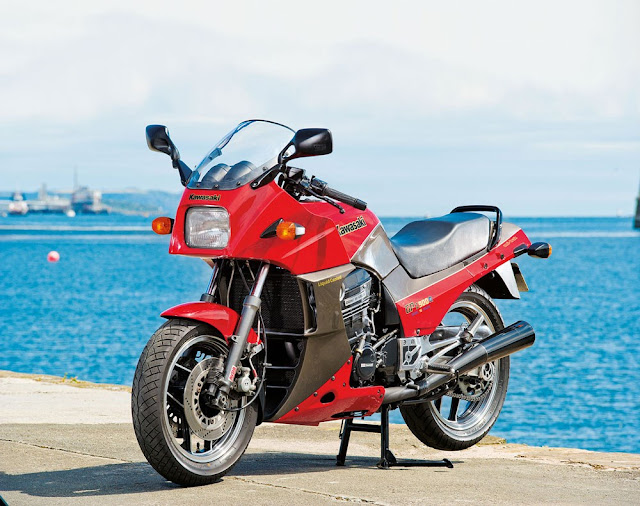Kawasaki GPZ900R
The Ninja’s aerodynamic full fairing and compact dimensions helped give the 908cc bike a top speed of over 150mph (241 km/h). The original bike’s 16-inch front wheel was changed to a wider 17- inch unit on later models.
The GPZ900R was the machine with which Kawasaki recaptured its reputation for unbeatable four-cylinder performance. When the firm’s first liquid-cooled four stormed onto the streets in 1984, the manner in which it delivered 150mph (241 km/h) top speed with smoothness and unprecedented refinement confirmed that a thrilling new era had begun.
And there was much more than sheer speed to the bike that in most markets was known as the Ninja. This was a 9()8cc machine that felt as compact as a 750 - and which outran its 1 lOOcc rivals when you opened the throttle. Street riders took to it in droves, production racers adopted it as their own. Almost everyone who rode the Ninja was won over by a machine that combined speed with reliability, handling, comfort and its own unmistakable style.
Kawasaki had spent the previous decade earning a reputation for brilliant air-cooled eight- valve motors, but the GPZ unit was distinctly different. As well as liquid-cooling, it featured a 16-valve cylinder head plus developments including a balancer shaft, camchain at the end of the crankshaft, and alternator above the six-speed gearbox. It was small, light and powerful, though its peak output of 113bhp at 9500rpm was slightly below that of the old GPzl 100.
The rest of the GPZ maintained the theme of high performance with minimum size and weight. Kawasaki called the bike’s frame layout a ‘diamond’ but essentially it was a steel spine design that used the engine as a stressed member, and which dispensed with the conventional downtubes. Aluminium was used for the square-section rear subframe, the box-section swingarm. and the large alloy footrest hangers on which it pivoted.
Front forks were 38mm units incorporating an anti-dive system that increased compression damping with suspension travel. Rear suspension was by Kawasaki’s Uni-Trak monoshock layout, with an air-assisted shock unit that could be adjusted for rebound damping. The front wheel was 16 inches in diameter, following the fashion of the day.
Searing speed
The sharply styled full fairing did a reasonable job of shielding the rider, who leant forward to fairly flat handlebars. The Ninja was low, sleek - and most of all it was fast. Due to its superior aerodynamics it had a top-speed edge over its GPzl 100 predecessor, with dramatic acceleration above 6000rpm and searing speed from 8000rpm to the l(),5()0rpm redline.
And the rest of the bike did not let it down. High-speed stability was exemplary, partly due to suspension that gave a superbly taut feel at the expense of some harshness at slower speeds. At over 500lb (227kg) the 900 was no lightweight, but by superbike standards it was very manageable, and its twin front disc brakes were hugely powerful.
The Kawasaki was also practical, combining a generous fuel range with reasonable comfort plus neat details including luggage hooks and a strong pillion grab-rail.
The Ninja’s success when launched was predictable, but even Kawasaki must have been pleasantly surprised by its long life. The 900 outlasted its intended replacements, the GPZ1000RX and the ZX-IO, and even in 1990 was not replaced but merely updated. The front wheel grew from 16 to 17 inches in diameter; both wheels were widened to allow fitment of fatter tyres; forks were thickened to 4lmm; and front brake discs were enlarged to 300mm and treated to new four- piston calipers.
As it remained in Kawasaki’s range during the 1990s. the once mighty Ninja came to be regarded as a budget-priced sports-tourer rather than a serious high-performance machine. But that should not diminish its reputation. What should be remembered is that in 1984 the GPZ900R was the undisputed king of the road. And that it started the dynast) of liquid-cooled. 16-valve Kawasaki fours that continues to this day.
Handling was superb by 1984 standards, thanks to a rigid steel frame, plus firm, anti-dive-equipped front forks and an efficient rising-rate monoshock rear suspension system.
Kawasaki's first four- valves-per-cylinder engine was a suitably impressive successor to the firm’s mighty two-valve fours. The initial ‘GPz’logo was later amended to ‘GPZ’ to distinguish the liquid- cooled range.
The GPZ 900R was the world’s top super bike in 1984. Its roadgoing prowess was confirmed by victories in numerous production races, including the revived Production TT.
Specification Kawasaki GPZ900R (1984)
- Engine Liquid-cooled dohc 16-valve four
- Capacity 908cc (72.5 x 55mm)
- Maximum power 113bhp @ 9500rpm
- Transmission Six-speed, chain final drive
- Frame Steel spine
- Suspension Telescopic front; single shock rear
- Brakes Twin discs front; disc rear
- Weight 502lb (228kg)
- Top speed 155mph (249km/h)
























0 comments: